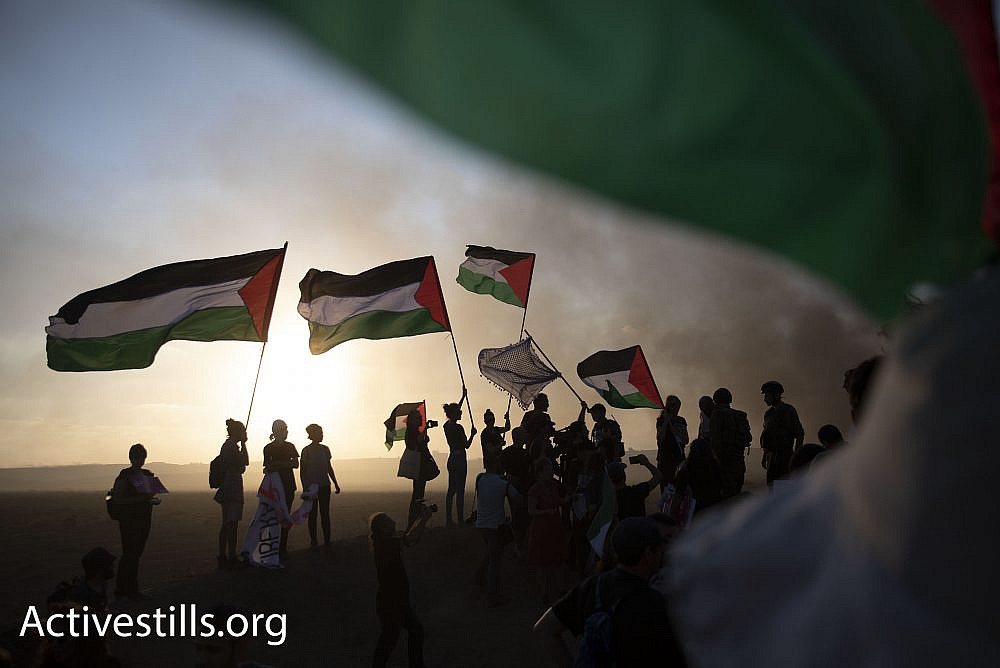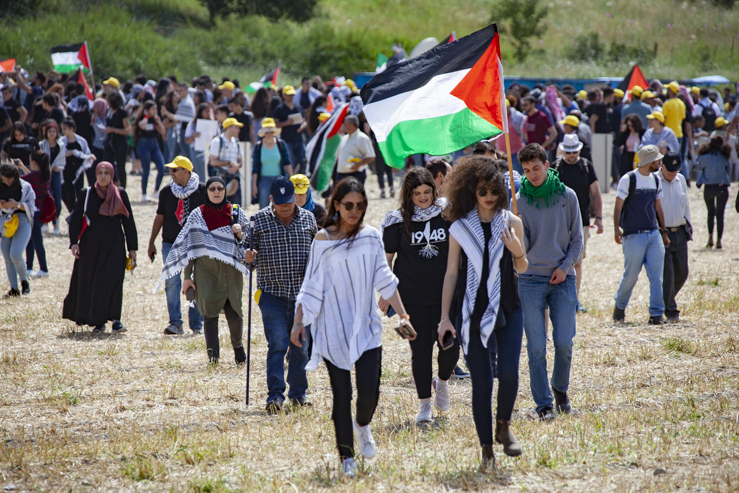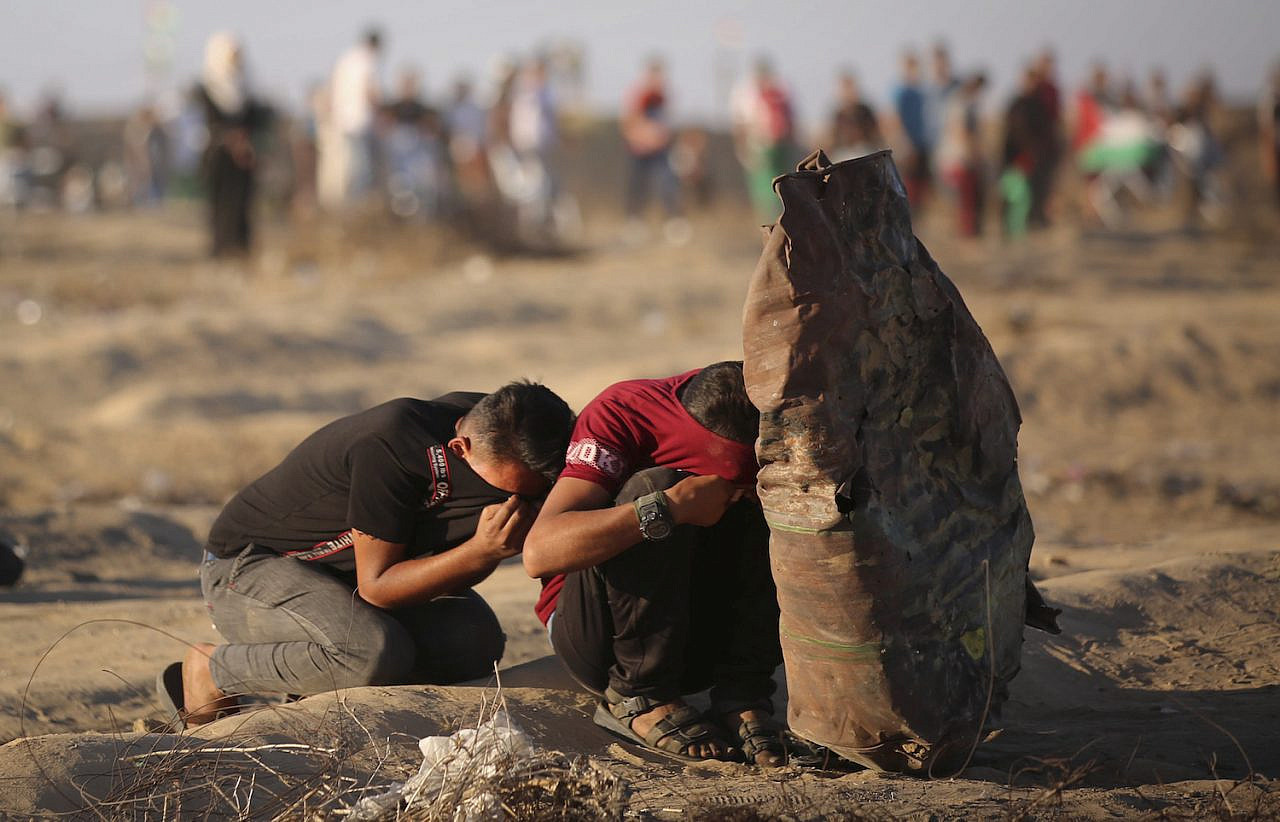Seven decades on, internally displaced Palestinians wait to return home
Muhammad Kayal is one of hundreds of thousands of Palestinian citizens of Israel who remain internally displaced 72 years after the Nakba, and whom Israel will not allow to return to their former — and often empty — land.

Dozens of Israeli and Palestinian activists protested on the Israeli side of the Gaza fence in solidarity with the Great Return March. Palestinian demonstrators responded with cheers of joy at the sight of the Palestinian flags. (Oren Ziv/Activestills.org)
 ByOrly NoyMay 15, 2020
ByOrly NoyMay 15, 2020 The
restrictions imposed by the coronavirus pandemic and the ban on large
gatherings have somewhat softened the emotional, symbolic, and physical
friction around Israeli Independence Day/Nakba Day this year.
The
restrictions imposed by the coronavirus pandemic and the ban on large
gatherings have somewhat softened the emotional, symbolic, and physical
friction around Israeli Independence Day/Nakba Day this year.Each year, Israel smugly celebrates itself through huge military flyovers and fireworks displays, rejecting with all its might the fact that it is a day of disaster for the Palestinians. Israelis are astonished anew each time that neither the passage of time nor draconian legislation have managed to erase the disaster — or uproot Palestinians’ consciousness of it.
It is doubtful as to how much Israelis are aware of the fact that even as they celebrate Independence Day in parks across the country each year, Palestinian citizens are holding yearly return marches to a different community their elders were expelled from in 1948, and to which they have never been able to go back.
Although the official date for marking Nakba Day is May 15, return marches traditionally take place on Israeli Independence Day (which changes each year, according to the Hebrew calendar). This year, however, the pandemic pushed the commemorations — which included other activities organized by the Committee for the Rights of Displaced Palestinians — onto Zoom, with a lower turnout than in previous years.
As much as the issue of return comes up in the Israeli discourse, it tends to focus on the return of Palestinian refugees currently living outside the country’s borders. Yet the Committee estimates there are some 400,000 internally-displaced people (IDPs) among Palestinian citizens of Israel.
Muhammad Kayal, a board member of the Committee and formerly its head, is a journalist and translator whose family was expelled from al-Birwa, near Akka in the country’s north. Kayal proudly refers to it as “the village of Mahmoud Darwish,” the late Palestinian poet. Today, he lives in Jedeidi-Makr, a little over a mile from al-Birwa, which is now the site of a kibbutz and an agricultural settlement.
What do you tell people who ask you where you’re from?
“I say that I’m from al-Birwa and live in Jedeidi. My father used to say all of his life ‘I’m from al-Birwa’,even though he had lived in Jedeidi for nearly 60 years. When he talked about ‘people from our village,’ he was referring to al-Birwa”.
Do the descendants of the village’s original inhabitants keep in touch? Do you know others who are part of that community, who share your identity?
“Absolutely, we’re in touch constantly. Firstly, every year on Independence Day — or rather, Nakba Day — residents of al-Birwa from all over the country meet on the village’s land. We invite hundreds of those expelled from al-Birwa and their descendants when we have celebrations, and on mourning days, thousands of them come to the village for comfort.”
How do you instill this consciousness in younger generations? If your father said until his dying day that he was from al-Birwa, and you say you’re from al-Birwa and Jedeidi, what will the next generation say?

“We take children and young people on return marches to the village on Nakba Day. We organize youth tours to depopulated villages, print t-shirts for them saying ‘I’m from al-Birwa’ in Arabic, and we have an active Facebook group for descendants of those expelled.
“We also have national poetry, such as that of Mahmoud Darwish, and projects like ‘Udna’ (Arabic for “we returned,” a joint project between the Committee, the Israeli NGO Zochrot, which focuses on the Nakba, and others — O. N.). It’s been running for three years, and takes young people to depopulated villages and involves a lot of lectures and written material.
“There are also films that deal with this topic. We had a special women’s project, ‘Women’s Path of Return,’ in which hundreds of women from different communities took part in tours, lectures, and movies about depopulated villages, which included many activities aimed at young people.”
Do you feel that it’s working? That this awareness is taking hold among the younger generation?
“You know, it’s like with everything — there are people who are more engaged and active, and those who are less. But if you take the return marches as an example, more than 70 percent of participants are young people from the second, third, and fourth generations of the Nakba.”
The Committee’s main task is to preserve memory and generate awareness. Do you intentionally refrain from concrete political activities that try to realize the right of return for refugees and IDPs?
“We work in coordination with the High Follow-Up Committee, which includes the Arab parties, for example when organizing the yearly marches. Every political movement participates in those.”
There’s a sense that the Joint List is wary of conflict surrounding this issue. The return of refugees and IDPs is not high up on its public agenda.
“I raised this exact question with a group of Joint List activists during the election campaign. They said it’s addressed in the Joint List’s publications aimed at Arab society. But that isn’t enough for us. Both the Palestinian Authority and the Joint List underplay the issue and don’t emphasize the Nakba and the right of return, focusing on other things instead. Yet talking about the Nakba and return is precisely the thing that will win them greater support in Arab society.
“It’s true that this topic is unpopular in Jewish society. They try to whitewash and downplay these issues, and yet here we are — Benny Gantz didn’t want [the Joint List]. Even the Palestinian Authority talks about the end of the occupation, about stopping the settlements, but don’t engage with the right of return. So it is with Abu Mazen [Palestinian President Mahmoud Abbas] and the Joint List. And all the while there are dozens of return marches happening in Gaza.

“It’s important to emphasize too that the Nakba isn’t over, it’s ongoing — home demolitions, expropriation of land, expulsion policies, the [Jewish] Nation-State Law. To this day, not a single refugee has been allowed to return to the village they were expelled from.”
The yearly marches usually head to remote areas, and there hasn’t been a mass march to Manshiyyeh, for example, or Sheikh Muwannis [destroyed Palestinian neighborhoods that are now areas of south and north Tel Aviv, respectively]. Is there fear around these marches becoming a site of direct confrontation with the Israeli establishment?
“Five hundred and thirty-one villages were depopulated in 1948, along with 11 cities, for example Akka, Haifa, Yaffa, Be’er Sheva, and others. There have been 22 marches so far, and this year the coronavirus prevented another one from taking place. In the past we organized a march to Wadi Zubala in the Naqab, and to the areas around Tiberias, Akka, and Haifa. There are many places we haven’t been to yet. We are definitely looking at the option of organizing a return march to one of the big cities.
“But in all sincerity, the Committee and its management is made up of representatives from depopulated villages and cities, and not everyone thinks the same way. Some are more cautious, some less. Some stand up for their rights more — in this case the right to protest and raise the issue of IDPs — and others who prefer to arrange for the marches to take place in an area where clashes are unlikely.
“Five years ago, we held a meeting in Haifa, and it was important to us that representatives from the area would be prepared for a march to take place there. But then the elections happened and people said they wanted to focus on that. We’re not saying no — on the contrary, we absolutely intend to hold one of the next marches in one of the big cities from which Palestinians were expelled.”
Throughout our conversation, Kayal frequently mentions Palestinian refugees scattered across the diaspora and their right to return to their land. I wonder which is more difficult: to yearn for your land from afar, from exile outside the country’s border, or from a house whose windows practically look out over the land to which you’re barred from returning.
“To this day, some of the elders of al-Birwa can point precisely to the piece of land that belonged to them,” Kayal says. “We need to remember that. A small kibbutz has taken over a giant area, while people in Jedeidi live in highly-cramped conditions with no land. So, of course they want to go back, and want their land.”
When you talk about returning to al-Birwa, do you mean living alongside the kibbutz and the agricultural settlement or in their place? When the issue of return is mentioned, many Jews engage with this question.
“In the vast majority of cases, the built-up area of the original villages is now empty land. That’s how it is with Iqrit and Bir’im, for example, and many other places, and people still aren’t allowed to go back. We’re not ignoring the current reality, but we believe that bringing about the right of return is possible. The barrier to this is a Zionist ideological-political one.
“We’re doing tours from the Naqab to the Upper Galilee. Most of the empty land has been declared as absentee properties, despite its owners still being present and citizens of the state that evicted them. It’s a political decision based on a racist ideology.”

No comments:
Post a Comment
Note: only a member of this blog may post a comment.